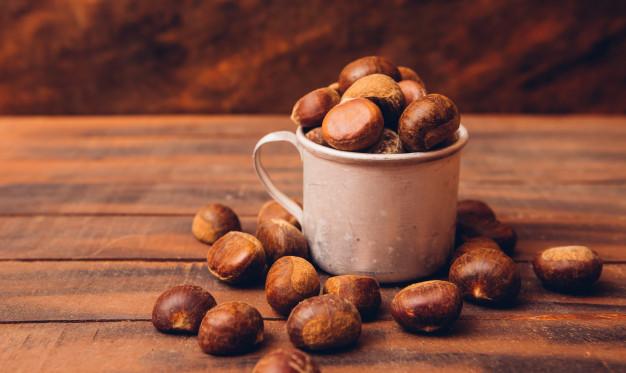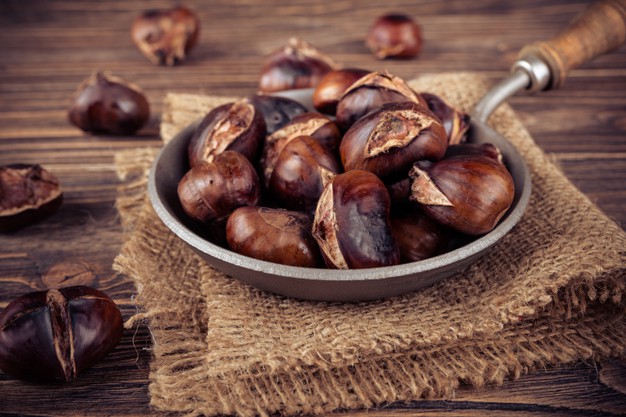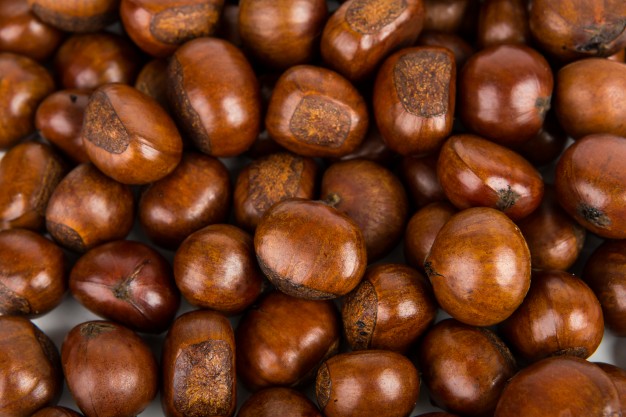Chestnut is an edible and nutritious nut obtained from trees of Castanea genus. It has been traditionally used for improving digestive health, cardiac health, immunity and skeletal functions.
Nutritional overview
- It contains significant amount of moisture
- It contains desirable amount of carbohydrates and dietary fibre
- It contains negligible amount of protein as well
- It contains trace amount of fat both saturated and unsaturated fat but does not contain any cholesterol
- It contains several vitamins like Vitamin A, Vitamin C, Vitamin B1, B2, B3, B5, B6 and B9
- It also contains numerous imperative trace elements that include calcium, phosphorus, sodium, potassium, copper, zinc, iron, magnesium and manganese
- It is packed with various phytochemicals, which offer incredible health benefits

Biological property
Antioxidant activity
- Gallocatechin gallate, ferulic acid, catechin gallate and epicatechin gallate components of chestnut act as strong antioxidant, which are associated with decreasing oxidative stress by reducing the concentration of free radicals within body
- Its consumption is very effective for decreasing the risk of developing chronic illness
Anti-carcinogenic activity
- Ferulic acid of chestnut is considered as the main component responsible for exerting anti-carcinogenic activities
- It helps to destroy cancerous cell
- It also helps to inhibit cellular proliferation of malignant cells that suppresses their further growth
- It helps to prevent metastasis as well
- It plays vital role in decreasing the prevalence of bone, breast, thyroid, skin and lung cancer

Health benefits
Role on immunity
- Consumption of chestnut significantly enhances immunological responses of the body
- Its Vitamin C, Vitamin A, copper, zinc, tannic acid, fatty acid and phenolic acid components are responsible for boosting up the overall immunity of body
- It helps to stimulate the synthesis of WBC that helps to strengthen the defense mechanism of body by promoting phagocytosis
- It also helps to protect the body from developing chronic diseases by enhancing body’s disease fighting capacity and by neutralizing free radicals within body
Role on digestive health
- Consumption of chestnut is very helpful for promoting digestion as it contains significant amount of magnesium, tannin, zinc and dietary fibre, which play imperative role in improving digestive health
- It also helps to increase the absorption of nutrients through intestinal epithelial cells
- Its fibre content is responsible for promoting bowel movement that helps to facilitate defecation and prevents constipation
- It is also associated with enhancing colonic motility hence improves colonic health
- It helps to protect the gastrointestinal tract from oxidative and from inflammatory damages thus reduces the prevalence of ulcerative colitis, inflammatory bowel diseases, irritable bowel syndrome, peptic ulcers, diarrhoea and other abdominal discomforts
- It has seen that consumption of chestnut is extremely effective for improving the gastric tolerance of lactobacilli
- Another important feature of chestnut is that it is absolutely gluten free thus individual suffer from celiac disease can easily include it in their diet

Role on skeletal system
- Calcium, phosphorus, copper and magnesium contents of chestnut play crucial role in strengthening the skeletal system of the body
- Its calcium and phosphorus contests help to enhance the growth and development of bones as they form calcium phosphate, which is the principal composition of bones
- Magnesium content of chestnut is responsible for increasing bone mineral density that helps to increase the strength and mass of bone
- Its copper content helps to absorb iron, which is essentially required for boosting up the skeletal growth
- It is better to consume chestnut for slowing down the onset of age related bone disorder especially osteoporosis
Role on nervous system
- It helps to promote the functioning of nervous system
- It is considered as one of the richest source of B vitamins and these B vitamins are essentially required for the growth and development of nervous system
- Potassium content of chest nut helps to promote blood circulation, which is associated with supplying enough blood to brain that helps to carry sufficient nutrients and oxygen to the brain cells and helps in their proper nourishment that ultimately improves the functionality of brain
- It also helps to improve memory and cognitive ability

Role on metabolism
- It helps in the metabolism of carbohydrate, protein and fat as it contains significant amount of B vitamins that act as cofactors for numerous enzymes involved in metabolic reactions

Role on electrolyte balance
- Its moisture, potassium, magnesium and calcium contents help to maintain the fluid and electrolyte balance of the body
- Consumption of water chestnut after strenuous exercise or after heavy sweating is a healthy choice as it helps to restore the losses of electrolytes and also helps in homeostasis
Role on weight management
- Obes individuals can simply include chestnut in their diet as it helps in successful weight reduction
- It is considered as a high volume food thus it is associated with providing a feeling of satiety (without providing enough calorie) that reduces craving hence decreases food consumption and facilitates weight reduction

Role on skin
- Antioxidant content of chest nut plays significant role in promoting skin health as it helps to protect the skin from oxidative damages and also helps to prevent ageing
- It helps to protect the skin from the harmful UV ray and helps to decrease the susceptibility of developing dermatological disorders
- Its consumption is also very effective for hydrating the skin
Therapeutic application
- It is traditionally used as an effective remedial action for preventing hypertension as it provides significant amount of potassium
- Its potassium content also helps to maintain the heart beat in normal range
- It has potent cholesterol lowering activity. Its significantly reduces the concentration of LDL, VLDL as well as triglyceride within blood hence helps to inhibit the prevalence of atherosclerosis
- It acts as an effective therapeutic agent for preventing cardiac disorders like coronary artery disease, angina pectoris, ischemic heart disease and myocardial infraction
- It also helps to decrease the risk of strokes and heart attacks
- It helps to avert blood clotting as well
- Its consumption is very effective for stimulating the synthesis of blood vessels, collagen, cartilage and muscle
- It also helps to decrease blood sugar concentration as it contains fibre (both soluble and insoluble) that helps to decrease glucose absorption from intestinal epithelial cells

General consideration of using chestnut
- It can be consumed as raw or boiled or fried or grilled or candied pickled
- It can utilized for both sweet and sour dishes
- It can be utilized as a thickener while preparing food as it contains significant amount of starch
- Ground form of chestnut can be effectively used as an alternative of flour
- It can also consumed with salads
- It can be used while preparing any curries
- Its nutrient and moisture content make it more susceptible for microbial contamination. So it is better to preserve it in well manner for preventing its spoilage. The best way of preserving chestnut is to keep it in refrigerator (within the temperature of -18°C to -20°C) either whole or peeled
Risk factors
Over consumption of chestnut should be avoided as it may cause various health complications like flatulence, indigestion, diarrhoea, nausea, dizziness, headache, calf spasm, itching and allergic reactions.

Source:
Choupina, A.B., 2019. Nutritional and health potential of European chestnut. Revista de Ciências Agrárias, 42(3), pp.801-807.
Garg, S., Hussain, N.A.A., Syed, I., Asaithambi, N. and Mundhada, S., 2020. Water Chestnut (Trapa natans). In Antioxidants in Vegetables and Nuts-Properties and Health Benefits (pp. 453-465). Springer, Singapore.
Hou, F., Shi, X., Li, Q., Xie, S., Wu, Y. and Ouyang, J., 2016. Nutritional quality of Chinese chestnut and effect of cooking on its bioactive compounds and antioxidant activity. Journal of Food Processing and Preservation, 40(6), pp.1383-1390.
Hussain, S.Z., Beigh, M.A., Naseer, B., Amin, T. and Naik, H.R., 2019. Characteristics of resistant starch in water chestnut flour as improved by preconditioning process. International Journal of Food Properties, 22(1), pp.449-461.
Mir, S.A., Bosco, S.J.D. and Shah, M.A., 2019. Technological and nutritional properties of gluten-free snacks based on brown rice and chestnut flour. Journal of the Saudi Society of Agricultural Sciences, 18(1), pp.89-94.
Paciulli, M., Mert, I.D., Rinaldi, M., Pugliese, A. and Chiavaro, E., 2019. Chestnut and Breads: Nutritional, Functional, and Technological Qualities. In Flour and Breads and their Fortification in Health and Disease Prevention (pp. 237-247). Academic Press.
Rafiq, S.I., Muzaffar, K. and Rafiq, S.M., 2020. Horse Chestnut. In Antioxidants in Vegetables and Nuts-Properties and Health Benefits (pp. 467-476). Springer, Singapore.


